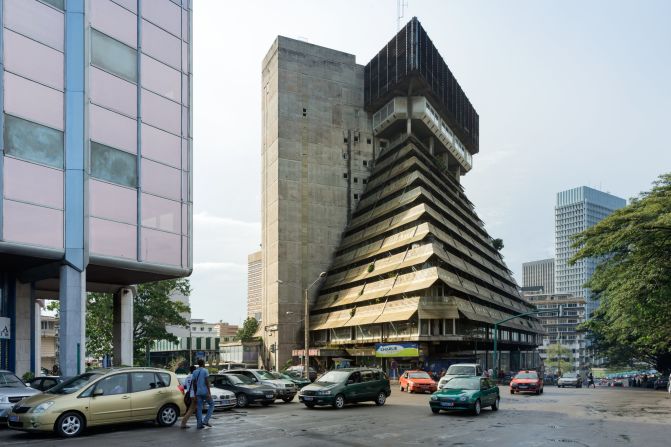
La Pyramide (Abidjan, Ivory Coast) —
Designed by Italian architect Rinaldo Olivier, La Pyramide was celebrated as one of the Ivory Coast's most impressive structures at the time of its completion."It was meant to recreate the liveliness of the traditional Ivorian marketplace, consciously (designed) in contrast to the sterile modern architecture that preceded it at this time," says Herz. Sadly, he notes, those aspirations never came to pass.
"Economically, it was never viable, and it's now gutted," he says.

Hotel Ivoire (Abidjan, Ivory Coast) —
The Hotel Ivoire was built in three stages between 1961 and 1970 at the behest of President Felix Houphouet-Boigny. Herz sees the building as "the alter-ego of the country."When the hotel was first built, it was done with the aspiration of attracting rich businessmen and glamor tourists. When the country experienced political upheaval in the late 1990s, it became a headquarters for the militia. In 2004, following mounting tensions with France, the hotel was the location where a disputed number of Ivorians were shot by the French army. Now, says Herz, the hotel has reopened and is returning to its roots.
"It has again become a glam hotel, and has almost followed the development of the country," he says.

Hotel Independence (Dakar, Senegal) —
In many ways, Senegal is one of the continent's greatest success stories, and that its post-colonial structures, like the Hotel Independence, are still in operation, attests to this. Herz says that one motivator of the exhibit was to focus on a side of Africa that he feels, is sorely underrepresented in the media.
"Almost every reportage of Africa is about misery, violence, crime, always with a negative connotation. Africa is never distinguished between its 54 countries, but seen as this gray mass of lack. The idea here is to shift the discourse and show an incredible wealth of cultural production," he says.

Kenyatta International Conference Center (Nairobi, Kenya) —
In 1973 -- the same year the Kenyatta International Conference Center (KICC for short) was opened -- it became a major international player in the world of finance. The IMF and World Bank hosted a conference at KICC, significantly elevating the status not just of the structure, but the newly independent country."It turned a building that was of national importance into one of international importance," says Herz. "It put Kenya on the map, and since it has become one of the most recognized buildings in Nairobi, and a symbol of Kenya's independence."

FIDAK (Dakar, Senegal) —
Herz notes that though many of the newly independent countries called in foreign architects to develop the new, post-colonial skyline, there is a separate national identity visible in the thumbprint of each structure. This is particularly true of Senegal, he notes, where the country's first president, Leopold Sedar Senghor, was a poet, and put a large emphasis on the arts. The Foire Internationale de Dakar, or FIDAK, for instance, came about during this period.

Independence Arch (Accra, Ghana) —
Designed by the Public Works Department, Independence Arch was built to put Ghana on the world stage."These countries were developing a new national identity. There was a clear interest for the young nation in gaining this eye-level perspective, to be amongst the league of nations," he says.

University of Zambia (Lusaka, Zambia) —
Just as the Hotel Ivoire became a symbol for the political realities of the Ivory Coast, the University of Zambia has proven a similar representation for Zambia's alliances, notes Herz. Zambia called on an Israeli construction company to build the university."The late Sixties were a honeymoon period between Israel and Africa. Israel was seen as a friend because it had also lived through colonialism and gotten rid of its colonial power," he explains. By the Seventies, tensions within Israel had soured the relationship, and the construction company was thrown out.
"They took all the plans with them, and there are still parts of the university that aren't complete," he says.

School of Engineering at KNUST (Kumasi, Ghana) —
For Kwame Nkrumah, Ghana's first president, education was a priority, says Herz."Nkrumah was singularly pushing this issue, so we see the construction of a tremendous amount of schools and universities at this time," he notes, all of which have what was then a heightened, modernist aesthetic.
"The KNUST campus really represent a purity of modern architecture," he adds.

Mfantsipim School (Cape Coast, Ghana) —
Completed one year after independence, the Mfantsipim School was actually commissioned in the preceding years. This, explains Merz, demonstrates that the concept of independence is in fact somewhat fluid, born in the years leading up to its realization."It shows there's not always a red line, a kind of hour zero," he says. "What architecture allows is an assessment of this process of independence. It allows us to see the gray tones in what we initially always thought was a black and white situation."